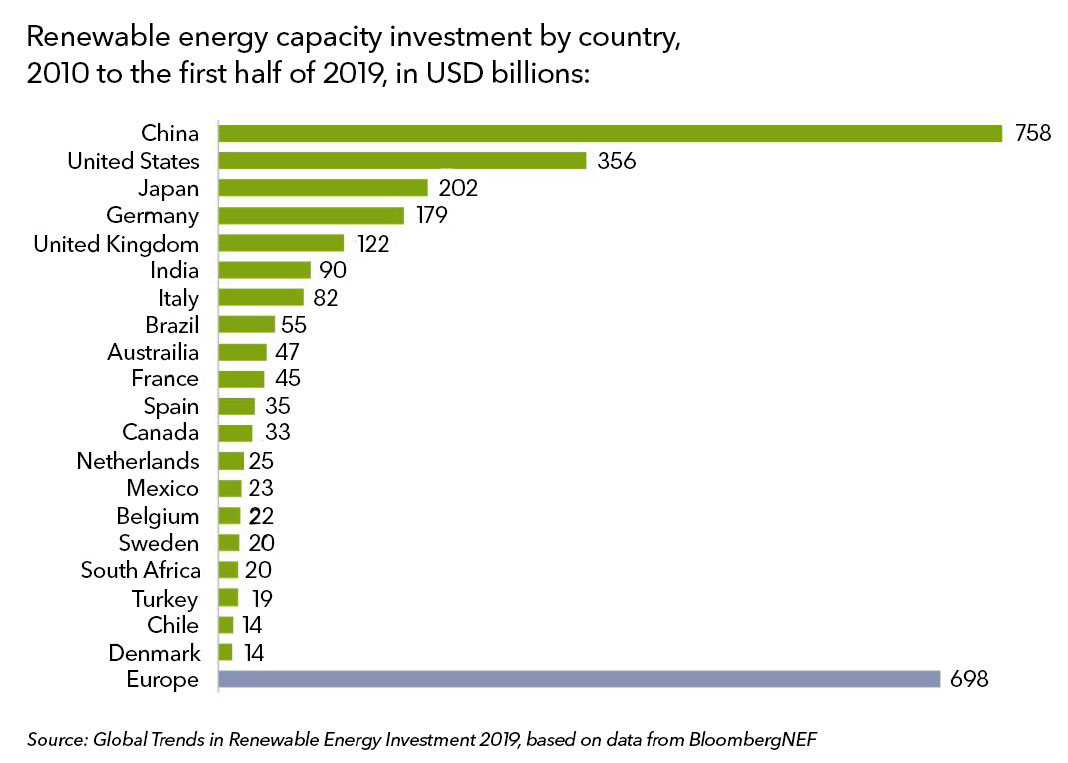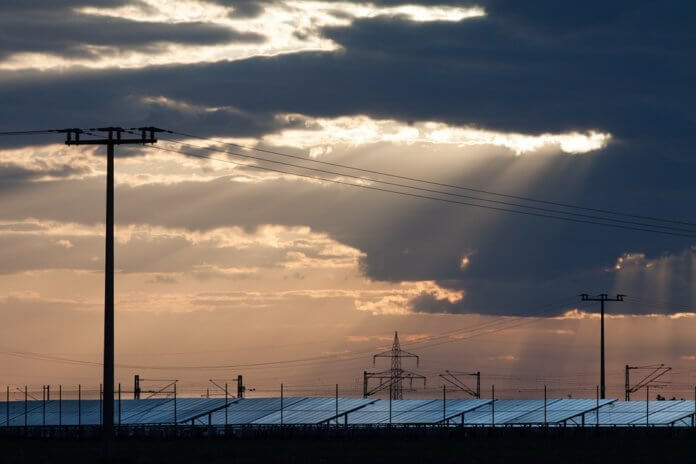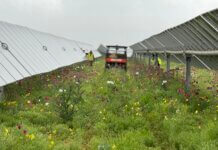Global investment in new renewable energy capacity over this decade – 2010 to 2019 inclusive – is on course to hit $2.6 trillion, with more gigawatts of solar power capacity installed than any other generation technology, according to new figures released by BloombergNEF (BNEF) and its research partners.
According to the “Global Trends in Renewable Energy Investment 2019” report, released ahead of the UN Global Climate Action Summit, this investment is set to have roughly quadrupled renewable energy capacity (excluding large hydro) from 414 GW at the end of 2009 to just over 1,650 GW when the decade closes at the end of this year.
BNEF says solar power will have drawn half – $1.3 trillion – of the $2.6 trillion in renewable energy capacity investments made over the decade. Solar alone will have grown from 25 GW at the beginning of 2010 to an expected 663 GW by the close of 2019 — enough to produce all the electricity needed each year by about 100 million average homes in the U.S., according to the report.
The global share of electricity generation accounted for by renewables reached 12.9% in 2018, up from 11.6% in 2017. This avoided an estimated 2 billion metric tons of carbon dioxide emissions last year alone – representing a substantial savings, given global power sector emissions of 13.7 billion metric tons in 2018, the report points out.
Including all major generating technologies (fossil and zero-carbon), the decade is set to see a net 2,366 GW of power capacity installed, with solar accounting for the largest single share (663 GW), coal second (529 GW), and wind and gas in third and fourth places (487 GW and 438 GW, respectively).
The cost-competitiveness of renewables has also risen dramatically over the decade. The levelized cost of electricity – a measure that allows a comparison of different methods of electricity generation on a consistent basis – is down 81% for solar photovoltaics since 2009; that for onshore wind is down 46%.
“Investing in renewable energy is investing in a sustainable and profitable future, as the last decade of incredible growth in renewables has shown,” notes Inger Andersen, executive director of the UN Environment Programme.
“But we cannot afford to be complacent,” Andersen continues. “Global power sector emissions have risen about 10 percent over this period. It is clear that we need to rapidly step up the pace of the global switch to renewables if we are to meet international climate and development goals.”

2018 sees quarter-trillion dollar mark exceeded again
The report, released annually since 2007, also continued its traditional look at yearly figures, with global investment in renewables capacity hitting $272.9 billion in 2018.
While this was down 12% over the previous year, 2018 was the ninth successive year in which capacity investment exceeded $200 billion and the fifth successive year above $250 billion. It was also about three times the global investment in coal and gas-fired generation capacity combined.
The 2018 figure was achieved despite continuing falls in the capital cost of solar and wind projects – and despite a policy change that hit investment in China in the second half of the year, notes BNEF.
A record 167 GW of new renewable energy capacity was completed in 2018, up from 160 GW in 2017, the report says.
Jon Moore, CEO of BNEF, remarks, “Sharp falls in the cost of electricity from wind and solar over recent years have transformed the choice facing policy-makers. These technologies were always low-carbon and relatively quick to build. Now, in many countries around the world, either wind or solar is the cheapest option for electricity generation.”
The report also tracks other non-capacity investments in renewables – money going into technology and specialist companies. All of these types of investment showed increases in 2018: Government and corporate research and development was up 10% at $13.1 billion, while equity raised by renewable energy companies on public markets was 6% higher at $6 billion, and venture capital and private equity investment was up 35% at $2 billion.
Overall renewable energy investment, including these categories, as well as capacity investment, reached $288.3 billion in 2018, down 11% on the record figure of $325 billion attained in 2017.
“It is important to see renewables becoming first choice in many places,” says Nils Stieglitz, president of Frankfurt School of Finance and Management in Germany. “But now we need to think beyond scaling up renewables. Divesting from coal is just one issue within the broader field of sustainable finance. Investors increasingly care whether what they do makes sense in the context of a low-carbon and sustainable future.”
China still leads, but renewables investment spreads
China has been by far the biggest investor in renewables capacity over this decade, having committed $758 billion between 2010 and the first half of 2019, with the U.S. second on $356 billion and Japan third on $202 billion, according to the report.
Europe as a whole invested $698 billion in renewables capacity over the same period, with Germany contributing the most at $179 billion, and the U.K. at $122 billion.
While China remained the largest single investor in 2018 (at $88.5 billion, down 38%), renewable energy capacity investment was more spread out across the globe than ever last year, with 29 countries each investing more than $1 billion, up from 25 in 2017 and 21 in 2016.
The Global Trends in Renewable Energy Investment report is commissioned by the UN Environment Programme in cooperation with Frankfurt School-UNEP Collaborating Centre for Climate & Sustainable Energy Finance and produced in collaboration with BloombergNEF. The report is supported by the German Federal Ministry for the Environment, Nature Conservation, and Nuclear Safety. The full report can be accessed here.




